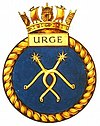 HMS Urge
| |
| History | |
|---|---|
| Name | Urge |
| Builder | Vickers Armstrong, Barrow-in-Furness |
| Laid down | 30 October 1939 |
| Launched | 19 August 1940 |
| Commissioned | 12 December 1940 |
| Fate | Sunk by German mine off Malta, 27 April 1942 |
| Badge |  |
| General characteristics | |
| Class and type | U-class submarine |
| Displacement |
|
| Length | 58.22 m (191 ft) |
| Beam | 4.90 m (16 ft 1 in) |
| Draught | 4.62 m (15 ft 2 in) |
| Propulsion |
|
| Speed |
|
| Complement | 32 |
| Armament |
|
HMS Urge was a British U-class submarine, of the second group of that class, built by Vickers Armstrong, Barrow-in-Furness. She was laid down on 30 October 1939, and was commissioned on 12 December 1940. From 1941 to 1942 she formed part of the 10th Submarine Flotilla based in Malta and spent most of her career operating in the Mediterranean, where she damaged and sank enemy warships and merchant vessels and undertook both SBS and SIS special operations. She was commanded by Lieutenant-Commander Edward Philip Tomkinson, DSO, RN. She was lost with all hands and a number of naval passengers (and one war correspondent) on 27 April 1942 after striking a German mine off Malta.[1]
Urge had an intensive 20-patrol career lasting a little over a year before her loss. In December 1941, Lieutenant-Commander Tomkinson received the DSO and bar, was mentioned in dispatches, and at his request, received two years' seniority in lieu of a second bar to the DSO; in 1942, further awards to Tomkinson were pending for the torpedoing of the Italian battleship Vittorio Veneto on 14 December 1941 and the sinking of the Italian cruiser Giovanni dalle Bande Nere on 1 April 1942, but he was lost before these awards could be made. Vice Admiral Sir Arthur Hezlet stated in his history of British Submarines in WW2 that had Tomkinson survived he would “almost certainly” have received a third bar to the DSO.[2] Vice-Admiral Sir Ian McGeogh, a post-war Flag Officer Submarines who served briefly on Urge in 1941, wrote that Tomkinson "should in my view have been awarded the Victoria Cross – preferably before he was lost."[3] HMS Urge's crew were awarded a number of Distinguished Service Crosses and Distinguished Service Medals. The first lieutenant was Lieutenant JMS Poole, DSC and Bar, RN. The chief petty officer, CJJ Jackman, was awarded the DSM and Bar and mentioned in despatches three times. At the time of her loss, the commander-in-chief Mediterranean reported to the Admiralty that the "loss of this outstanding submarine and commanding officer is much to be regretted."
Urge was adopted and partially funded by the people of the Welsh town Bridgend, as a result of the national "warship week" in 1941.[4]
In 1948 a building at HMS Dolphin was named after HMS Urge (along with other famous WW2 submarines). In 1975, a building at HMS Dolphin in Gosport, was named after Lieutenant-Commander Tomkinson, alongside others named after other leading Royal Navy World War II submarine captains.
In late October 2019, it was announced that a maritime archeology project (Project Spur) had discovered the wreck of the submarine off the coast of Malta. The project was led by Timmy Gambin of the Archeology and Classics Department of the University of Malta, Francis Dickinson, a grandson of Lieutenant-Commander Tomkinson, and Platon Alexiades, a naval researcher from Canada. The search was conducted by a team led by Professor Gambin.
In 2022 a memorial to those who lost their lives while serving in HMS Urge was unveiled at Fort St Elmo in Malta by the President of Malta and the British High Commissioner to Malta. The unveiling formed part of a number of events to commemorate those lost, which included a wreath laying at sea and was attended by HMS Urge families and friends and the Royal Navy Submarine Service.
- ^ "WW2 submarine Urge found off Malta". Royal Navy. 31 October 2019. Retrieved 26 March 2021.
- ^ British and Allied Submarine Operations in World War II, Vice Admiral Sir Arthur Hezlet, 2001
- ^ Ian McGeoch, An Affair of Chances, IWM 1991
- ^ BBC News - Missing submarine found